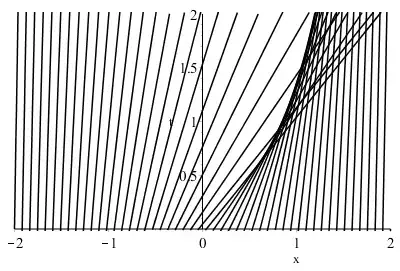I'm trying to solve the following partial differential equations: $$ u_t + \frac{1}{3}{u_x}^3 = 0 \tag{a} $$ $$ u_t + \frac{1}{3}{u_x}^3 = -cu \tag{b} $$ with the initial value problem $$ u(x,0)=h(x)= \left\lbrace \begin{aligned} &e^{x}-1 & &\text{for}\quad x<0\\ &e^{-x}-1 & &\text{for}\quad x>0 \end{aligned} \right. $$ My idea was to set $v(x,t)=u_x(x,t)$, because then I get the transport equation in $v$ which I am able to solve: $v_t + v^2v_x =0$. But when I do this, my solution for $v$ is $$ v(x,t)= \left\lbrace \begin{aligned} &\phantom{-}ae^{x-v^2 t} & &\text{for}\quad x<0\\ &{-a}e^{-x+v^2 t} & &\text{for}\quad x>0 \end{aligned} \right. $$ Can someone help me with this equation? Is $u_x = a e^{x-u_x^2 t}$ the correct answer? Or should I maybe do something very different to solve this equation?
1 Answers
Both equations (a) and (b) are Hamilton-Jacobi equations. Indeed, they are derived from a canonical transformation involving a type-2 generating function $u(x,t)$ which makes vanish the new Hamiltonian $$ K = H(x,u_x) + (\partial_t + c)\, u \, . $$ Here, $H(q,p)=\frac{1}{3}p^3$ is the original Hamiltonian and $\partial_t + c$ defines the time-differentiation operator. Setting $v=u_x$, we have $$ v_t = u_{tx} = -\left(\tfrac{1}{3}{u_x}^3\right)_x - cu_x = -v^2v_{x} - cv \, . $$ Thus, we consider the first-order quasilinear PDE $v_t + v^2v_{x} = -cv$ with initial data $v(x,0) = h'(x) = \pm e^{\pm x}$ for $\pm x<0$, and we apply the method of characteristics:
- $\frac{\text d t}{\text d s} = 1$, letting $t(0)=0$, we know $t=s$.
- $\frac{\text d v}{\text d s} = -cv$, letting $v(0)=h'(x_0)$, we know $v=h'(x_0)e^{-ct}$.
- $\frac{\text d x}{\text d s} = v^2$, letting $x(0)=x_0$, we know $x=\frac{1}{2c}h'(x_0)^2(1-e^{-2ct}) + x_0$.
Injecting $h'(x_0) = ve^{ct}$ in the equation of characteristics, one obtains the implicit equation $$ v = h'\!\left(x-v^2\frac{e^{2ct}-1}{2c}\right) e^{-ct}\, . $$ Along the same characteristic curves, we have
- $\frac{\text d u}{\text d s} = \tfrac23 v^3 - c u$, letting $u(0) = h(x_0)$, we know $u = h(x_0) e^{-ct} + \frac23\! \int_0^t e^{-c(t-s)} v(s)^3 \text d s$.
Thus, we get $$ u = \left(h\!\left(x-v^2\frac{e^{2ct}-1}{2c}\right) + h'\!\left(x-v^2\frac{e^{2ct}-1}{2c}\right)^3 \frac{1-e^{-2ct}}{3c} \right) e^{-ct} \, , $$ where the link between $x_0$ and $v$ along characteristics has been used. For short times, the previous solution is valid. The method of characteristics breaks down when characteristics intersect (breaking time). We use the fact that $\frac{\text d x}{\text d x_0}$ vanishes at the breaking time $$ t_B = \inf_{x_0\in \Bbb R} \frac{-1}{2 c} \ln\left(1 + \frac{c}{h'(x_0)h''(x_0)}\right) . $$ However, it seems pointless to look further for full analytical expressions in the general case.
If $c=0$, the characteristics are straight lines $x=x_0+v^2t$ along which $v=h'(x_0)$ is constant, and along which $u = h(x_0) + \frac23 v^3 t$. A sketch of the $x$-$t$ plane is displayed below:
The breaking time becomes $t_B = \inf_{x_0} -(2h'(x_0)h''(x_0))^{-1} = 1/2$. For short times $t<t_B$, the implicit equation for $v$ reads $v = h'(x-v^2t)$, i.e. $v = \pm e^{\pm (x-v^2t)}$ if $\pm(x-v^2t)<0$. Its analytic solution $$ v(x,t) = \pm\exp\! \left(\pm x- \tfrac{1}{2}W(\pm 2t e^{\pm 2x})\right) \quad\text{for}\quad {\pm (}x-t) < 0 $$ involves the Lambert W function. The expression of $u$ is deduced from $u = h(x-v^2 t) + \frac23 v^3 t$. For larger times $t>t_B$, particular care should be taken when computing weak solutions (shock waves) since the flux $f:v\mapsto \frac{1}{3}v^3$ is nonconvex.
- 20,898
-
Thank you a lot for your answer! So with this method, you get a formula for $v$, but not for $u$? But if I want to compute u, for $c=0$ I could calculate $u$ with the formula for the Hamilton-Jacobi equation. Is there any way to compute $u$ directly if $c \neq 0$? – Infinite_28 Oct 25 '18 at 21:54
-
Okay, thanks. So there is no theory how to solve a non homogeneous Hamilton-Jacobi equation and get an explicit formula of the function, is there? – Infinite_28 Oct 26 '18 at 16:46
-
@Infinite_28 Maybe you were hoping that there is a Lax-Hopf formula for this non-homogeneous HJE... I don't know if such a thing exists, but at least we can find $v=u_x$ via the method of characteristics. – EditPiAf Dec 11 '18 at 21:53
